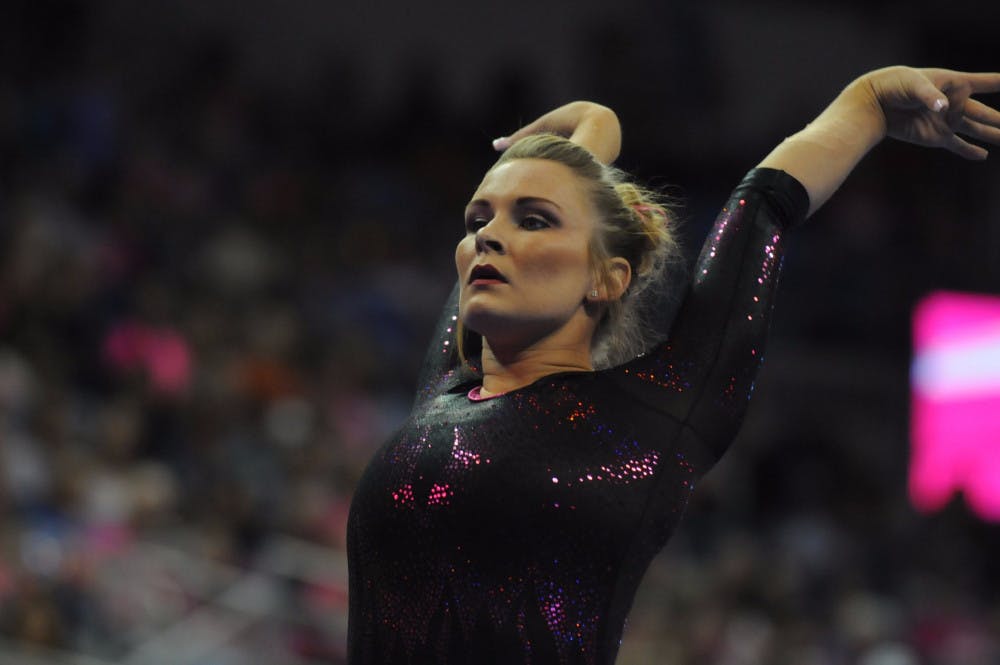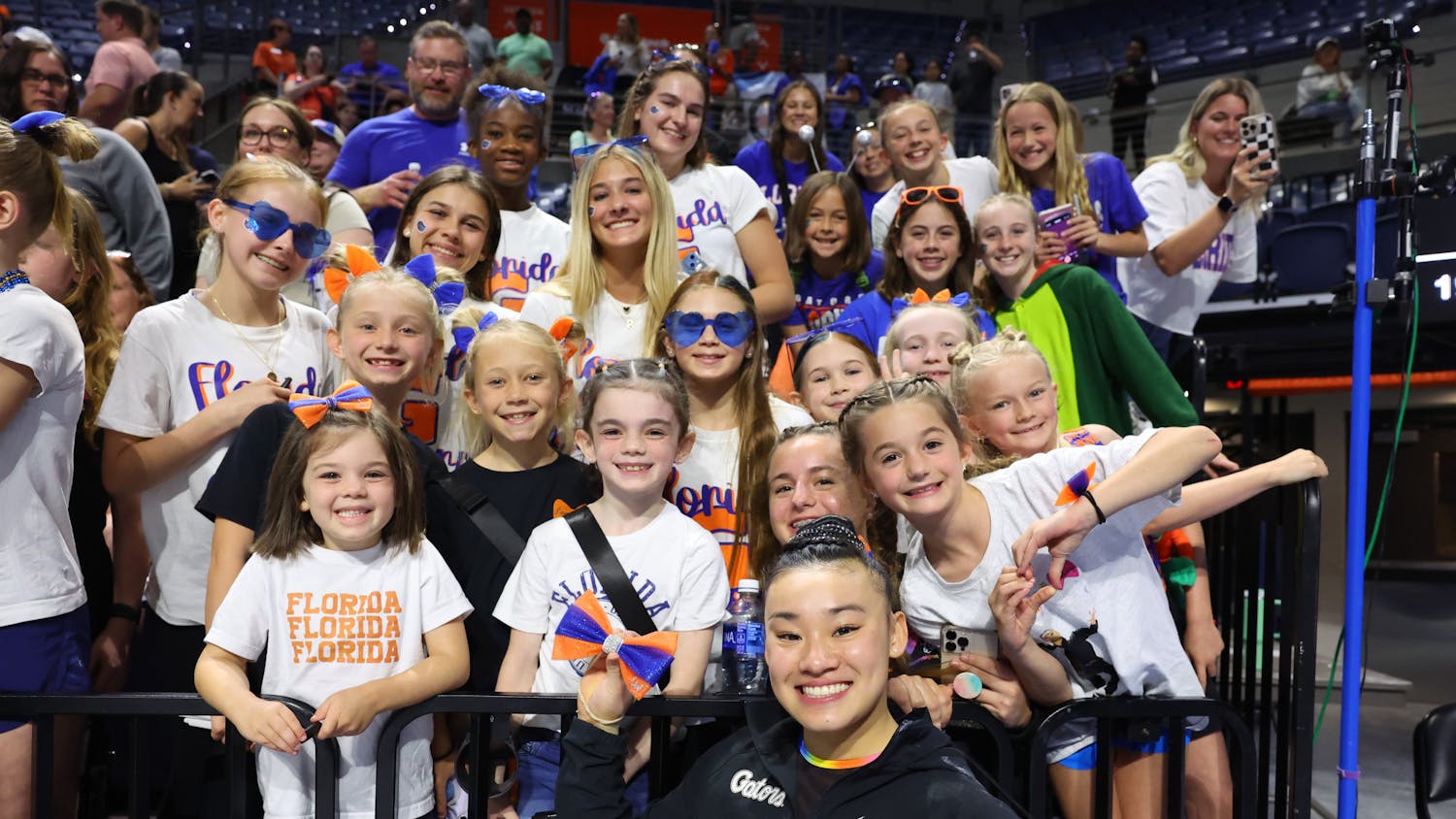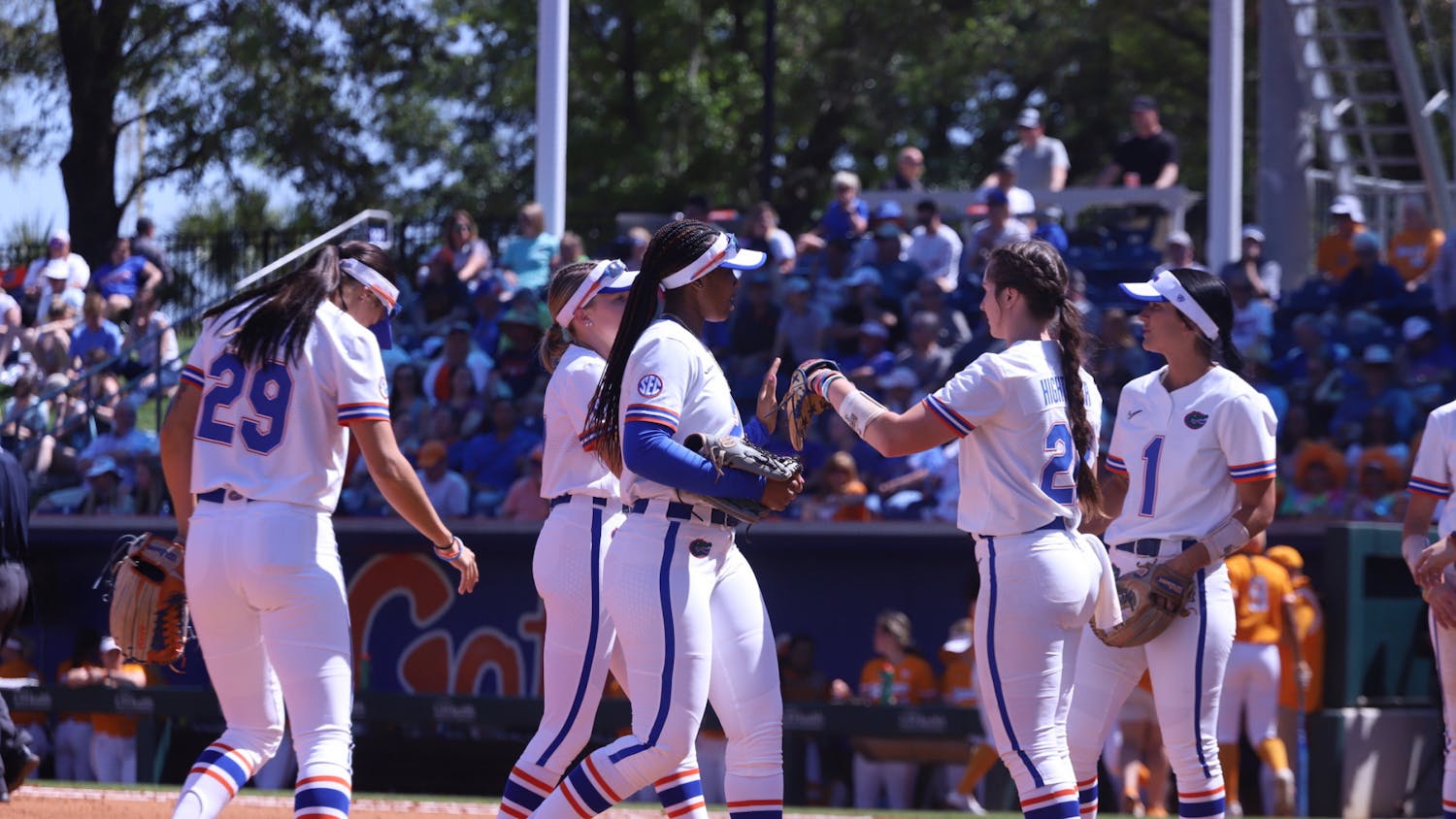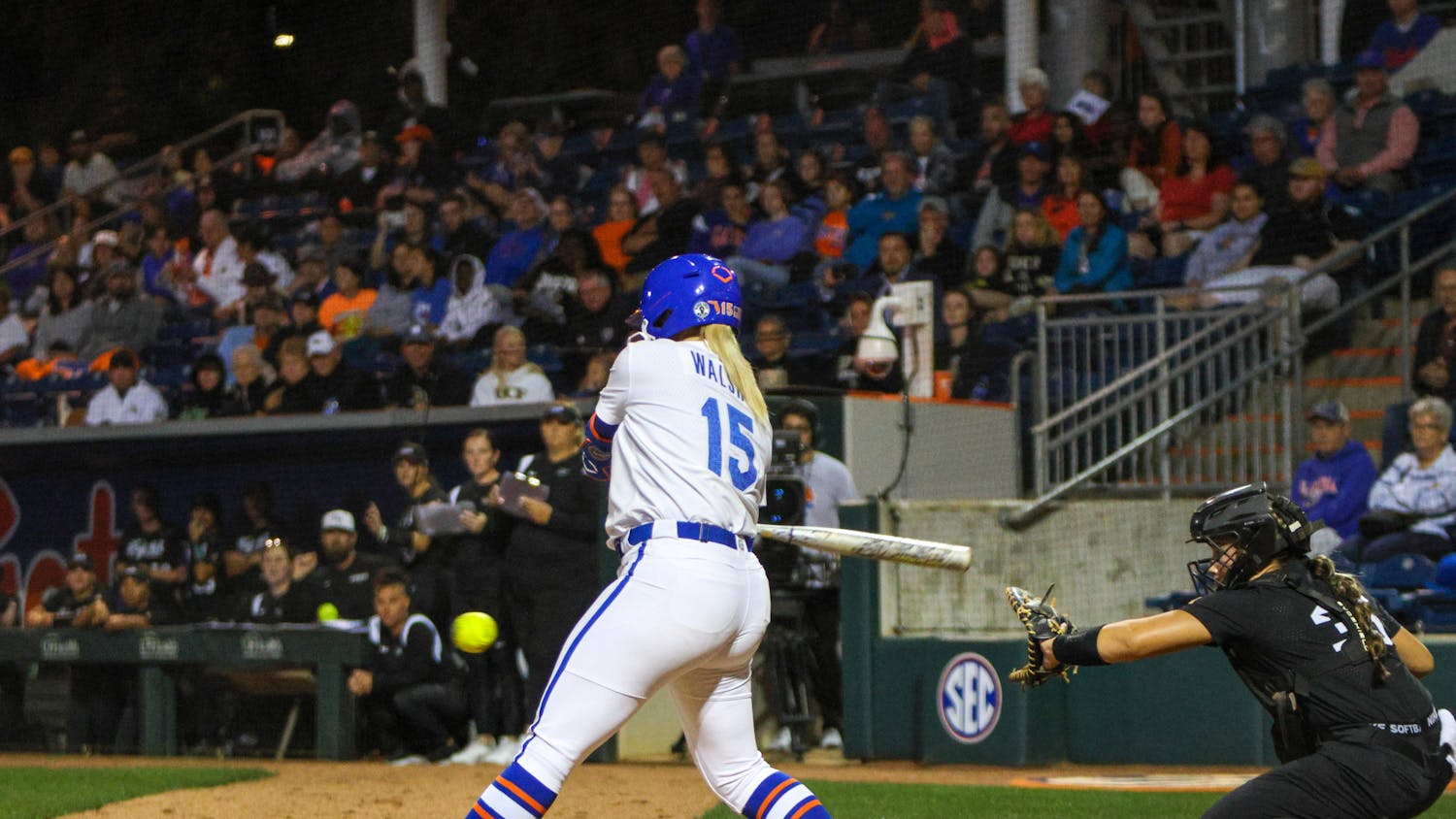Bridget Sloan called it her slump period.
She spent the entire month of May thinking. What are my goals? What should I do next? What do I want from life?
She was 23, when most young adults are just beginning to chase their lifelong dreams.
But Sloan had already chased hers.
At 16, she won a silver medal at the 2008 Beijing Olympics. At Florida, she became a six-time NCAA Champion, a 31-time All-American and the most decorated gymnast in UF history.
But after she graduated last April, she was no longer Bridget Sloan the star gymnast, the world-champion athlete, the high-flying record-breaker with the sparkling blue and white leotard.
She was just Bridget Sloan: the job-seeking adult.
Hire me, please.
“As athletes, we dedicate so much time to our sport without even thinking about it,” Sloan said. “And then at the end, it’s kind of like, ‘Oh shoot. My sport is over.’
“I’m not exactly sure what I’m supposed to do now.”
• • •
The interview was over, but the microphone was still turned on.
The SEC Network producer was listening.
Sloan was still an athlete at Florida. And each weekend, in front of 10,000 fans, she twisted and contorted her body to pop music in the O’Connell Center, the anchor of a star-studded, three-time NCAA champion gymnastics team.
But Sloan knew, sitting in that chair after her interview, that gymnastics wouldn’t last much longer. Eventually, she would need a job.
“If anybody out there is listening,” Sloan said into the mic, “I want to work at the SEC Network. This is my dream.”
The producer heard her, and Sloan was hired in January.
She fit all the SEC Network’s requirements. She was one of the best gymnasts in the country and had more gymnastics experience than almost anyone in the world. She liked to talk, often speaking in long paragraphs when a sentence or two would suffice. She was a hard worker, usually taking 16 credit hours per semester in college, four more than was required by the NCAA.
And, as the SEC Network soon found out, she could improvise.
She worked her first live broadcast during a Missouri-Auburn gymnastics meet on March 3 with Laura Rutledge, an ESPN and SEC Network analyst. But technical difficulties muddled the shoot, and the two women didn’t get a chance to rehearse. Rutledge always rehearsed.
“OK, there’s a chance that she freezes up,” Rutledge remembers thinking. “I’m gonna have to figure out how to carry this.”
Then they went live, and something changed. Sloan was poised and confident. She explained each of the gymnasts’ routines, what they had erred on and what they were doing correctly, pausing to allow for Rutledge’s input.
She was relaxed speaking about what she knew better than anything else — gymnastics.
Rutledge was relieved.
“This person competed in the Olympics and succeeded,” Rutledge said. “She’s competed on the biggest stage, on a 4-inch wide balance beam, 4 feet in the air by yourself. And your team’s fate is on your shoulders.
“Pressure is not really a factor for her.”
• • •
Before Florida, she was alone.
For thousands of hours, Sloan was in the gym, swinging from bars, flipping across mats and twisting on balance beams.
Training for the Olympics meant at least five hours in the gym every day. Even after the Olympics, after high school graduation, she took an entire year off just to train. It was hard to imagine life outside the gym.
Then she went to Florida. And while the 20 hours a week spent training for UF was less than what she had been through, she was still busy.
For the first time, she was competing not just for herself, but for a team.
Gymnastics is often a lonely and individualized sport, Sloan said, and as a teenager at Sharp’s Gymnastics Academy in Indiana, training from 2:30 p.m. to 8 p.m. every day for months on end, it was usually just her, the trainer and a balance beam.
But not at Florida. Her teammates were her friends. And this was her school.
“I did everything in my power to make sure Florida was on top,” Sloan said. “Everything that I did was for UF.”
Even as she dominated college gymnastics with titles and championships, thousands of fans roaring every time she flashed a smile and saluted with a Gator chomp, she mostly avoided the spotlight.
During classes at Florida, when teachers would hold icebreakers, urging each student to open up with three interesting things about themselves, she never mentioned that she was one of the best gymnasts in the world. Only that she was born in Indiana, she has three siblings, and, oh, she’s the youngest.
Sloan was occasionally recognized around campus, and always stopped to take a picture when she was asked. But she was also thankful for the heavy coats of makeup she wore on Fridays during meets — it kept her from being recognized when she went to class without the blush and eye-liner.
“Even today, when people are like, did you go to the Olympics? I’m like, ‘Yeah, a long time ago,’” Sloan said. “I’ve always looked at my athletic accolades as a little confidence booster for me and for me only.”
Although Sloan kept to herself, she often made trips to former UF athletics director Jeremy Foley’s office to seek advice, talk about the future and, after she graduated, to admit that she didn’t know what to do next.
“Well,” Foley would tell her, “join the club.”
After Sloan graduated, she wanted to become a brand ambassador with Nike, working in a major city like Miami, running the company’s accounts and staying up-to-date on Nike’s new products. But Nike doesn’t usually hand out jobs to newly graduated college students.
Instead, after she earned a telecommunication degree from Florida last April, she got a temporary job running State Farm Insurance’s local Twitter account. But she told herself it wouldn’t be long term.
So she waited.
“I truly believe that something is gonna come up,” Sloan said in July. ”A permanent position somewhere. And it’ll be fine.”
• • •
Laura Rutledge remembers all of their names.
Madison Kocian, UCLA.
MyKayla Skinner, Utah.
Sarah Finnegan, LSU.
“Bridget was one of the first true, elite Olympic gymnasts that decided to go to college,” Rutledge said. “And it started this great trend.”
After Sloan committed to Florida in 2010, making the move from a world stage to a college town in Gainesville, others, like Kocian and Skinner and Finnegan, followed suit.
After all, by age 16, their careers were nearly over. All the years of training, the competition, the red, white and blue jackets with the word “USA” etched on the back — finished.
By gymnastics standards, they were old.
“You truly do peak at 16,” Sloan said. “People think that it’s so abnormal.”
For many, figuring out what to do for the rest of their lives can be challenging. Some have nowhere to go, so they return to their schools after they graduate to become assistant coaches, Rutledge said, like Lauren Beers at Alabama or Brandie Jay and Brittany Rogers at Georgia.
“It is so difficult for them,” Rutledge said. “If you think about it, if that’s been your way of life, and not just a way of life, but if you’ve dedicated everything to this sport, what else do you have? What else do you do? Who am I without gymnastics?”
And while some return to their alma matters, others are still looking for jobs.
Florida holds events specifically for its student athletes designed to help them decide what they want to do after college, said Keith Carodine, Florida’s senior associate athletic director of academic affairs.
UF even lends its athletes free suits and holds a separate career fair where they can meet with potential employers. But of the 500 or so athletes at UF, Carodine said, usually only 100 attend.
“I think any graduate, especially from UF, may have this vision that we’re gonna graduate college, have a great job lined up,” Sloan said. “The older I got, the more I kind of realized it’s a tough world out there.”
***
She paces along the edge of the black mat. She hears her name announced one last time.
That breaks her. Her focused stare suddenly softens into a smile. The crowd yells louder, and Bridget Sloan — wearing a midnight-black leotard with blue and silver stripes — looks around, taking in the cheering fans in the O’Connell Center. One last time.
Then Sloan does it. She front flips. She back flips. She twists and glides and soars over the mat in the last regular season meet of her Florida career. Then she lands, and she holds that Gator Chomp steady.
Her teammates rush onto the mat and swarm her. She earns a perfect 10.
Just over a year later, Sloan is working for the SEC Network. She’s sitting in a TV studio in St. Louis, wearing grey pants and a black button down T-shirt.
Less flashy than her gymnastic days.
“Could you still do any of that?” the host asks her.
Sloan pauses.
“If it was a life or death situation,” Sloan says after a laugh. “But right now, we’re not really doing gymnastics.”
As an SEC Network analyst, these types of appearances are now normal for Sloan — appear on TV, break down a college gymnastics meet, provide insight from the perspective of a former Olympian.
But the transition from athlete to broadcaster has not been easy, Rutledge said, despite how seamless Sloan makes it look.
After nearly a year of searching, Sloan just feels fortunate to have found a landing spot.
“I don’t think there’s anyone that can say, ‘I had absolutely no problem going from being an athlete to not being an athlete.’ I mean, you’re obviously going to miss it,” Sloan said.
“It’s what we’ve done our whole life.”
Contact Ian Cohen at icohen@alligator.org and follow him on Twitter @icohenb.
Where former Florida athletes are now:
Olivia Janowicz, former women’s tennis player, 2010-2014
Janowicz’s attempt at a professional playing career was cut short by injuries. She suffered a stress fracture in her foot as a senior while competing in the NCAA Tournament. She had surgery, but her foot wouldn’t heal fast enough, and she was forced to give up her dreams of playing professionally.
Now, Janowicz works for JTCC, a non-profit agency in Washington D.C. that teaches tennis in low-income neighborhoods and schools.
Casey Prather, former men’s basketball player, 2010-2014
Prather went unselected in the 2014 NBA Draft. After a short stint in the NBA Development league, Prather signed with the Perth Wildcats in Australia as part of the National Basketball League. Prather and the Wildcats won the 2016 NBL Championship, and Prather was named Perth’s MVP.
Mackenzie Dagostino, former women’s volleyball player, 2013-2015
In March, Dagostino was named the new volleyball coach at Berkeley Prep in Tampa, where she took over for her father Randy, who coached at the school for 29 years, winning 15 state championships. Dagostino last played for Florida in 2015 as UF’s starting setter.
In their words:
Bridget Sloan: “I think there’s a lot of people who assume that athletes get everything handed to them. They don’t have to work for anything, grades are not important. ‘Oh you’re an athlete, how does it feel to get everything handed to you?’ That is not how it works. Whatsoever.”
Olivia Janowicz, on transition from athlete to normal life: “It’s definitely rough. There’s no way to sugar coat it. Because you have all these things to do, and your schedule is set for you, and you have your classes set and you’re so busy in life. And the second you graduate NCAAs, it’s like radio silence. It’s just silence.”
Laura Rutledge, on life challenges that come with gymnastics: “If you think about it, if that’s been your way of life, and not just a way of life, but if you’ve dedicated everything to this sport, you’re essentially trying to reach one goal, which is the Olympics. And there’s only, what, eight people, not even, that make the Olympic team every four years? It’s just an almost unattainable goal that you’re trying to reach. It’s a constant struggle that a lot of them have to deal with.”
Bridget Sloan performs on the balance beam during Florida's win against Arkansas on Feb. 12, 2016, in the O'Connell Center.






